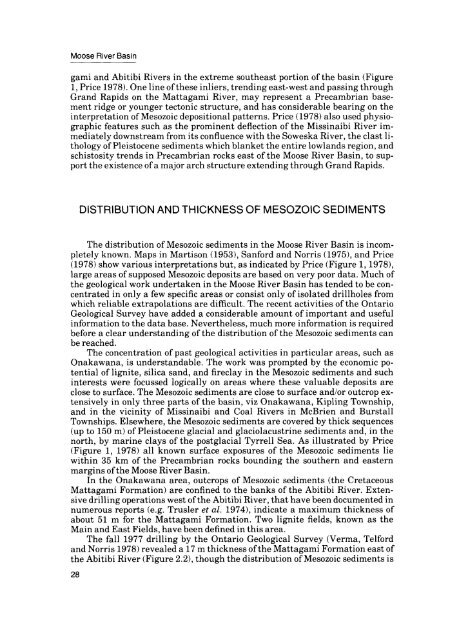Moose River Basin: geology and mineral potential - Geology Ontario
Moose River Basin: geology and mineral potential - Geology Ontario
Moose River Basin: geology and mineral potential - Geology Ontario
Create successful ePaper yourself
Turn your PDF publications into a flip-book with our unique Google optimized e-Paper software.
<strong>Moose</strong> <strong>River</strong> <strong>Basin</strong><br />
garni <strong>and</strong> Abitibi <strong>River</strong>s in the extreme southeast portion of the basin (Figure<br />
l, Price 1978). One line of these inliers, trending east-west <strong>and</strong> passing through<br />
Gr<strong>and</strong> Rapids on the Mattagami <strong>River</strong>, may represent a Precambrian base<br />
ment ridge or younger tectonic structure, <strong>and</strong> has considerable bearing on the<br />
interpretation of Mesozoic depositional patterns. Price (1978) also used physio<br />
graphic features such as the prominent deflection of the Missinaibi <strong>River</strong> im<br />
mediately downstream from its confluence with the Soweska <strong>River</strong>, the clast li<br />
thology of Pleistocene sediments which blanket the entire lowl<strong>and</strong>s region, <strong>and</strong><br />
schistosity trends in Precambrian rocks east of the <strong>Moose</strong> <strong>River</strong> <strong>Basin</strong>, to sup<br />
port the existence of a major arch structure extending through Gr<strong>and</strong> Rapids.<br />
DISTRIBUTION AND THICKNESS OF MESOZOIC SEDIMENTS<br />
The distribution of Mesozoic sediments in the <strong>Moose</strong> <strong>River</strong> <strong>Basin</strong> is incom<br />
pletely known. Maps in Martison (1953), Sanford <strong>and</strong> Norris (1975), <strong>and</strong> Price<br />
(1978) show various interpretations but, as indicated by Price (Figure l, 1978),<br />
large areas of supposed Mesozoic deposits are based on very poor data. Much of<br />
the geological work undertaken in the <strong>Moose</strong> <strong>River</strong> <strong>Basin</strong> has tended to be con<br />
centrated in only a few specific areas or consist only of isolated drillholes from<br />
which reliable extrapolations are difficult. The recent activities of the <strong>Ontario</strong><br />
Geological Survey have added a considerable amount of important <strong>and</strong> useful<br />
information to the data base. Nevertheless, much more information is required<br />
before a clear underst<strong>and</strong>ing of the distribution of the Mesozoic sediments can<br />
be reached.<br />
The concentration of past geological activities in particular areas, such as<br />
Onakawana, is underst<strong>and</strong>able. The work was prompted by the economic po<br />
tential of lignite, silica s<strong>and</strong>, <strong>and</strong> fireclay in the Mesozoic sediments <strong>and</strong> such<br />
interests were focussed logically on areas where these valuable deposits are<br />
close to surface. The Mesozoic sediments are close to surface <strong>and</strong>/or outcrop ex<br />
tensively in only three parts of the basin, viz Onakawana, Kipling Township,<br />
<strong>and</strong> in the vicinity of Missinaibi <strong>and</strong> Coal <strong>River</strong>s in McBrien <strong>and</strong> Burstall<br />
Townships. Elsewhere, the Mesozoic sediments are covered by thick sequences<br />
(up to 150 m) of Pleistocene glacial <strong>and</strong> glaciolacustrine sediments <strong>and</strong>, in the<br />
north, by marine clays of the postglacial Tyrrell Sea. As illustrated by Price<br />
(Figure l, 1978) all known surface exposures of the Mesozoic sediments lie<br />
within 35 km of the Precambrian rocks bounding the southern <strong>and</strong> eastern<br />
margins of the <strong>Moose</strong> <strong>River</strong> <strong>Basin</strong>.<br />
In the Onakawana area, outcrops of Mesozoic sediments (the Cretaceous<br />
Mattagami Formation) are confined to the banks of the Abitibi <strong>River</strong>. Exten<br />
sive drilling operations west of the Abitibi <strong>River</strong>, that have been documented in<br />
numerous reports (e.g. Trusler et al. 1974), indicate a maximum thickness of<br />
about 51 m for the Mattagami Formation. Two lignite fields, known as the<br />
Main <strong>and</strong> East Fields, have been defined in this area.<br />
The fall 1977 drilling by the <strong>Ontario</strong> Geological Survey (Verma, Telford<br />
<strong>and</strong> Norris 1978) revealed a 17 m thickness of the Mattagami Formation east of<br />
the Abitibi <strong>River</strong> (Figure 2.2), though the distribution of Mesozoic sediments is<br />
28

















